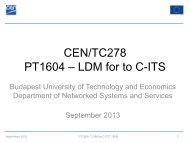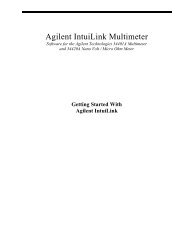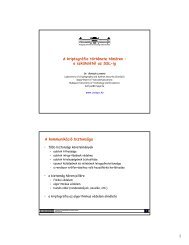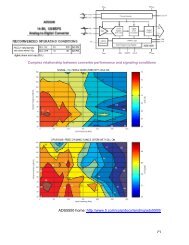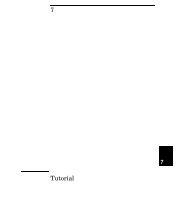Optimization algorithms for the sound design of chimney and tuning ...
Optimization algorithms for the sound design of chimney and tuning ...
Optimization algorithms for the sound design of chimney and tuning ...
You also want an ePaper? Increase the reach of your titles
YUMPU automatically turns print PDFs into web optimized ePapers that Google loves.
Sound pressure measured at mouth [dBSPL]<br />
Table 1: Dimensions <strong>of</strong> <strong>the</strong> example <strong>chimney</strong> pipe<br />
Parameters<br />
Values [mm]<br />
Original Optimized<br />
Chimney length 180.0 56.0<br />
Chimney diameter 19.0 29.3<br />
Resonator length 600.0 852.5<br />
Resonator diameter 79.0<br />
Mouth width 19.0<br />
Mouth height 60.0<br />
110<br />
100<br />
90<br />
80<br />
70<br />
60<br />
50<br />
40<br />
30<br />
20<br />
10<br />
SPL measured at mouth<br />
Calculated admittance<br />
Fundamental: 131 Hz<br />
Fifth partial: 655 Hz<br />
0<br />
0 500 1000 1500<br />
Frequency [Hz]<br />
Figure 2: Comparison <strong>of</strong> SPL measured at pipe mouth <strong>and</strong><br />
optimized input admittance <strong>of</strong> <strong>the</strong> example <strong>chimney</strong> pipe.<br />
a slot, <strong>the</strong> geometry becomes irregular <strong>and</strong> <strong>the</strong> onedimensional<br />
pipe model has to be extended to treat this<br />
discontinuity. Several models were developed <strong>and</strong> applied<br />
to model <strong>the</strong> similar case <strong>of</strong> woodwind instrument<br />
tone holes with success. However, <strong>tuning</strong> slots differ from<br />
<strong>the</strong>m by <strong>the</strong>ir non-circular shape <strong>and</strong> <strong>the</strong> thin pipe walls.<br />
Due to <strong>the</strong>se dissimilarities tone hole models can only be<br />
applied <strong>for</strong> <strong>tuning</strong> slots as a rough approximation.<br />
Recently, Lefebvre & Scavone [5] proposed a simulation<br />
method to investigate properties <strong>of</strong> woodwind tone holes<br />
with improved accuracy. Their technique can be interpreted<br />
to <strong>tuning</strong> slot simulation, as shown in Fig. 3. The<br />
basis <strong>of</strong> <strong>the</strong> method is to identify <strong>the</strong> transfer matrix<br />
(TM) <strong>of</strong> <strong>the</strong> <strong>tuning</strong> slot separate from <strong>the</strong> pipe by placing<br />
it into a symmetrical cylindrical section, <strong>for</strong> which<br />
<strong>the</strong> TM is known. Then <strong>the</strong> equivalent conentrated parameter<br />
circuit <strong>of</strong> <strong>the</strong> slot can be determined <strong>and</strong> used in<br />
<strong>the</strong> one-dimensional model.<br />
Validations per<strong>for</strong>med on experimental <strong>tuning</strong> slot pipes<br />
have shown good correspondence <strong>of</strong> <strong>the</strong> simulated input<br />
admittance <strong>and</strong> measured <strong>sound</strong> pressure, as displayed in<br />
Fig. 4. These results can serve as <strong>the</strong> basis <strong>of</strong> <strong>the</strong> development<br />
<strong>of</strong> an optimization method <strong>for</strong> <strong>the</strong> <strong>sound</strong> <strong>design</strong><br />
<strong>of</strong> <strong>tuning</strong> slot organ pipes, similar to <strong>the</strong> one presented<br />
<strong>for</strong> <strong>chimney</strong> pipes.<br />
Acknowledgments<br />
The financial support <strong>of</strong> <strong>the</strong> research by <strong>the</strong> European<br />
Commission (Grant Agreement Ref# 222104) is grate-<br />
60<br />
40<br />
20<br />
0<br />
−20<br />
−40<br />
Input admittance [dB re. 1/Z P0<br />
]<br />
Sound pressure measured at mouth [dBSPL]<br />
Symmetry plane A<br />
Symmetry plane B<br />
Tuning slot<br />
Domain extension<br />
(PML on surface)<br />
Input plane y<br />
z<br />
x<br />
Figure 3: Arrangement <strong>for</strong> numerical simulations<br />
110<br />
100<br />
SPL measured at mouth 70<br />
Simulated admittance<br />
90<br />
60<br />
80<br />
50<br />
70<br />
40<br />
60<br />
30<br />
50<br />
20<br />
40<br />
10<br />
30<br />
0<br />
20<br />
−10<br />
10<br />
−20<br />
0<br />
−30<br />
0 500 1000 1500<br />
Frequency [Hz]<br />
Figure 4: Validation <strong>of</strong> <strong>tuning</strong> slot simulation by comparison<br />
to measurement<br />
fully acknowledged. P. Rucz acknowledges <strong>the</strong> support<br />
<strong>of</strong> <strong>the</strong> Hungarian research grant TÁMOP - 4.2.2.B-10/1–<br />
2010-0009.<br />
References<br />
[1] H. Levine <strong>and</strong> J. Schwinger. On <strong>the</strong> radiation <strong>of</strong><br />
<strong>sound</strong> from an unflanged circular pipe. Physical Review,<br />
73(4):383–406, 1948.<br />
[2] N. H. Fletcher <strong>and</strong> T. D. Rossing. The physics <strong>of</strong><br />
musical instruments, page 475. Springer, 1991.<br />
[3] J. A. Nelder <strong>and</strong> R. Mead. A simplex method <strong>for</strong> function<br />
minimalization. The Computer Journal, 7:308–<br />
313, 1965.<br />
[4] J. C. Lagarias, J. A. Reed, M. H. Wright, <strong>and</strong> P. E.<br />
Wright. Convergence properties <strong>of</strong> <strong>the</strong> Nelder-Mead<br />
simplex method in low dimensions. SIAM Journal <strong>of</strong><br />
<strong>Optimization</strong>, 9(1):112–147, 1998.<br />
[5] A. Lefebvre <strong>and</strong> G. P. Scavone. Refinements to <strong>the</strong><br />
model <strong>of</strong> a single woodwind instrument tonehole. In<br />
Proceedings <strong>of</strong> 20th International Symposium on Music<br />
Acoustics, Sydney <strong>and</strong> Katoomba, Australia, August<br />
2010.<br />
Input admittance [dB re. 1/Z P0<br />
]



